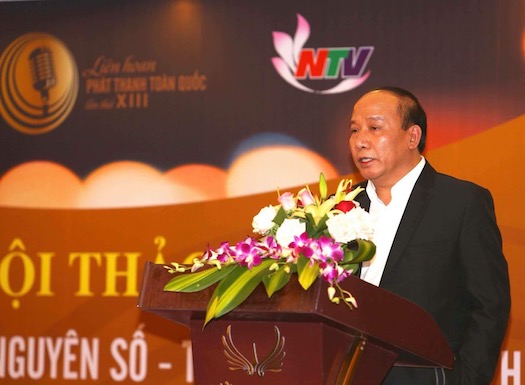Four international speakers discussed new trends in the challenging modern media landscape, during Vietnam’s 2018 Radio Festival last week.
Opening the session, Voice of Vietnam’s Vice Director General Tran Minh Hung (pictured) outlined the dramatic changes of the past few years and how they have given radio “a difficult time.”
“We have to catch up,” he said.
Speakers on the expert panel offered ideas and examples of how to catch up, drawing on international experiences.
Steve Ahern, from AMT Australia, described the way production teams have evolved in successful Australian radio companies. “Now there are one or two multi media producers in each major capital city production team. They are expected to post behind the scenes videos, catch up audio and engage with the audience on social media, all while the program is in progress and after it goes off air.”
Technology has made the media cycle faster and audiences expect a constant churn of information on multiple platforms, so broadcasters must find ways to do this, according to Ahern, who demonstrated examples of useful tools such as Omny Studio, Rewind Radio, Krzana.com, Hootsuite, podcast apps and others to illustrate methods of improving production. “Try everything, if it fails, learn from the experience of trying,” said Ahern.
Joanne Ha from KBS Korea outlined her broadcaster’s innovations in responding to new audience expectations. “We have tried many things to stay relevant to our audience,” she said, explaining innovations such as the company’s online platform Kong and the development of the integrated platform MyK, as ways to deliver content to audiences in new ways on mobile phones. The Kong Radio Player has had over 5 million downloads.
KBS is the biggest public broadcaster in Korea, with 2 television channels, 6 radio channels and programs in 11 languages. Like most countries, Korea is also experiencing a decline to traditional radio listening, but it is also experiencing an increase in listening to audio on new platforms such as smartphones.
KBS is reaching out to listeners on many new platforms to ensure that they continue listening to its radio programs. On the Kong platform listeners can listen to live audio, catch up on past programs, interact through messaging and social media, share content with friends and watch videos from the studio. KBS shows are also available on the Korean podcast platform PodBang.
She also explained how podcasts can develop new programs and attract new audiences, using the example of the podcast called “Petty-Minded Creep,” a satirical political analysis program that has built a huge audience. The presenter now has his own morning show on one of the main radio channels, which brought the ratings for that timeslot from less than 1% to over 10%.
Le Quoc Minh, the Vice President of Vietnam News Agency, explored international examples of changing audience habits, introducing the importance of experimenting with new delivery methods such as Virtual Reality and developing quality news content on social media to combat the bad effects of fake news.
NHK’s Head of Human Interface Research, Masakazu Iwaki outlined the way the Japanese national broadcaster has developed an artificial intelligence monitoring tool to track Japanese social media posts 24/7, so that newsrooms and broadcasters can get advance notice of what is happening in news and disasters before the stories break in main stream media.
After the presentations, the audience engaged in a lively question and answer session, exploring all the issues raised by the presenters.
In the evening, winners of the National Radio Awards were revealed at a glittering ceremony in the VoV Concert hall.

